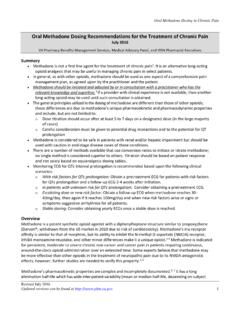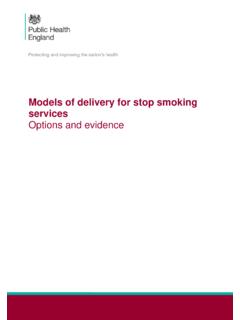Transcription of Buprenorphine Transdermal Delivery System (BUTRANS), C-III
1 Updated version may be found at or PBM INTRAnet 1 Buprenorphine Transdermal Delivery System (BUTRANS), C-III National Drug Monograph October 2015 VA Pharmacy Benefits Management Services, Medical Advisory Panel, and VISN Pharmacist Executives The purpose of VA PBM Services drug monographs is to provide a focused drug review for making formulary decisions. Updates will be made when new clinical data warrant additional formulary discussion. Documents will be placed in the Archive section when the information is deemed to be no longer current. FDA Approval Information Description/Mechanism of Action BTDS is the first 7-day sustained-action opioid formulation and the second opioid to become available as a patch in the and the only Schedule III and low-strength opioid available in a sustained-action and non-oral form for chronic pain.
2 Buprenorphine is a high-affinity, slow receptor-dissociating opioid that induces analgesia primarily through partial agonist activity; , intermediate intrinsic activity at the mu-opioid GTP-binding regulatory transducer protein (G-protein) coupled receptors (GPCRs). It has antagonist activity at kappa receptors, agonist activity at delta-opioid receptors, and partial agonist activity at nociceptin/orphanin FQ (NOP) receptors (also referred to as opioid receptor like-1 (ORL-1) nociceptin receptors).1,8 In addition, Buprenorphine may produce antinociceptive / analgesic effects through nonopioid receptor-related mechanisms not shared with other Indication(s) Under Review in This Document FDA-approved Use: Management of moderate to severe chronic pain in patients requiring a continuous, around-the-clock opioid analgesic for an extended period of time.
3 Potential Off-label Uses: As bridge therapy to prevent withdrawal symptoms when converting from high-dose full mu-agonist opioid analgesics to high-dose (8 32 mg/d) sublingual Buprenorphine for pain management (off-label use)1 Use of higher than US recommended doses. Antihyperalgesic effects or neuropathic pain Treatment of pruritus in primary biliary cirrhosis (single case report)2 Inappropriate for acute pain and use in postoperative settings Not indicated for management of opioid use disorder / opioid addiction Dosage Form(s) Under Review 5, , 10, 15, and 20 mcg/h Transdermal System REMS REMS No REMS Postmarketing Requirements See Other Considerations for additional REMS information Pregnancy Rating Category C Executive Summary Efficacy Buprenorphine Transdermal System (BTDS, 5 20 mcg/h every 7 days)
4 Seems to have a small analgesic effect size in the treatment of moderate to severe chronic noncancer pain, mainly low back pain and hip or knee osteoarthritic pain. The analgesic effect of BTDS is comparable to those of tramadol, oxycodone / acetaminophen and hydrocodone / acetaminophen. Safety The safety profile of BTDS has been well characterized and mainly consists of adverse reactions typical of opioids and local application site reactions associated with patches. Updated version may be found at or PBM INTRAnet 2 Potential safety advantages include a lower risk of respiratory depression due to a ceiling effect on respiratory depression (in the absence of other central nervous System (CNS) depressants), milder opioid withdrawal syndrome upon discontinuation of therapy, lower potential for physical dependence, and lower potential for abuse / addiction than with Schedule II opioids.
5 The dose of BTDS does not need to be adjusted in patients with renal impairment and in elderly patients. However, caution and close monitoring are still required because of the potential for increased risk of respiratory depression. QTc prolongation may occur if doses above the recommended maximum of 20 mcg/h are used. Other Considerations When switching patients from oral MEDDs of 30 to 80 mg to BTDS, a patch strength of 10 mcg/h (which may be equianalgesic to an oral MEDD of 18 28 mg) is recommended as a conservative initial conversion dose. The highest available BTDS strength of 20 mcg/h may be equianalgesic to an oral MEDD of 36 55 mg, whereas the product information states that the 20 mcg/h patch may not provide adequate analgesia for patients requiring greater than an oral MEDD of 80 mg.
6 In the UK, a morphine-to-BTDS equivalence ratio of 75:1 to 115:1 (average 95:1) is suggested. Projected Place in Therapy BTDS may be a useful alternative to other low-strength opioid analgesic products ( , tramadol, codeine/acetaminophen, hydrocodone/acetaminophen, or oxycodone/acetaminophen) for patients with moderate to severe chronic low back pain or chronic osteoarthritic pain who have had an inadequate response or intolerance to nonopioid, nondrug and other low-strength opioid therapies and require around-the-clock, low-strength opioid analgesics for pain control. BTDS may be more useful than other low-strength opioids in patients who have difficulty swallowing, poor or unpredictable gastrointestinal absorption ( , short bowel; nausea, vomiting), or renal impairment ( , the elderly).
7 Background Purpose for review FDA approval (June 2010) of new formulation and indication of Buprenorphine . Issues to be determined: Evidence of need Does BTDS offer advantages to currently available alternatives? Does BTDS offer advantages over current VANF agents? What safety issues need to be considered? Does BTDS have specific characteristics best managed by the nonformulary process, prior authorization, criteria for use? Other therapeutic options There are no other partial agonist opioids marketed for pain management in the Butorphanol for injection is the only mixed agonist-antagonist opioid approved for pain on the VA National Formulary. There are no non-orally administered opioids on formulary other than fentanyl patches.
8 Alternative oral, rectal and Transdermal opioid products are shown below. Formulary Alternatives Other Considerations [MEDD80 *] CFU, Restrictions or Other Guidance Tramadol Tab, C-IV C-IV scheduling reflects a lower likelihood of abuse, addiction and diversion than C-II and C-III [Unable to calculate MEDD80; exceeds the 400-mg recommended maximum daily dose of tramadol] Codeine / Acetaminophen Elixir, Tab, C-III [MEDD80 exceeds the 240-mg recommended maximum daily dose of codeine] Codeine Tab, C-II Not recommended for chronic pain management because of weak Updated version may be found at or PBM INTRAnet 3 analgesic effects as monotherapy [MEDD80 exceeds the 240-mg recommended maximum daily dose of codeine] Hydrocodone / Acetaminophen Liquid, Tab, C-II Oral liquids vary in drug concentrations.
9 Consider total daily dose of acetaminophen. [80 mg/d] Oxycodone / Acetaminophen Liquid, Tab, C-II Consider total daily dose of acetaminophen. [53 mg/d] Hydromorphone, C-II, Tab [20 mg/d] Morphine sulfate controlled release (MS Contin, generics) IR/SA Cap, IR/SA Tab, Liquid, Conc Soln, C-II Those patients who require morphine-equivalent daily doses (MEDDs) of >80 mg for analgesia may not be candidates for BTDS since the maximal recommended dose of BTDS (20 mcg/h or mg/24 h) will most likely not provide equivalent levels of analgesia. Criteria for Use of Controlled-release Oxycodone [refers to place in therapy of morphine] Methadone (generics) Tab, C-II [19 mg/d] Methadone Dosing Recommendations for Treatment of Chronic Pain Criteria for Use of Controlled-release Oxycodone [refers to place in therapy of methadone] Fentanyl Transdermal System (DURAGESIC, generics), C-II [22 mcg/h] Criteria for Use, Fentanyl Transdermal Systems Oxycodone Liquid, Tab, C-II [53 mg/d] Buprenorphine and Buprenorphine / Naloxone Sublingual Tablets (generic equivalents of SUBOXONE), C-III Available in high Buprenorphine strengths ranging from 2 to 12 mg.
10 FDA-approved for the treatment of opioid dependence under a Drug Addiction Treatment Act (DATA) 2000 waiver. Sublingual Buprenorphine and Buprenorphine / naloxone approved for opioid dependence / addiction have been used off-label for the treatment of patients with chronic pain1,3,4; however, the use of high-strength sublingual Buprenorphine or Buprenorphine /naloxone solely for pain management is not sufficiently supported by evidence. [Unable to calculate] Buprenorphine / Naloxone and Buprenorphine for Opioid Dependence, Criteria for Use for Office-Based Opioid Treatment (OBOT) Settings Nonformulary Alternatives Other Considerations [MEDD80*] CFU, Restrictions or Other Guidance Hydrocodone Tab ER 24-Hour Abuse Deterrent (HYSINGLA ER), C-II [80 mg/d] Hydrocodone Cap ER 12-Hour (ZOHYDRO ER), C-II Non-abuse deterrent formulation is on VA No Buy List Hydromorphone Liquid and Tab ER 24-Hour Abuse Deterrent (EXALGO, generics), C-II [20 mg/d] Hydromorphone Rectal Suppository 3 mg, C-II Many factors can cause variable absorption.














